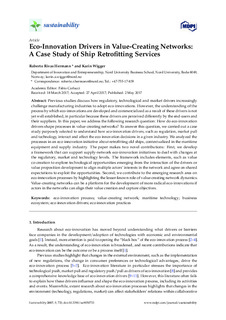Eco-Innovation Drivers in Value-Creating Networks : A Case Study of Ship Retrofitting Services
Journal article, Peer reviewed
Published version
Permanent lenke
http://hdl.handle.net/11250/2445347Utgivelsesdato
2017Metadata
Vis full innførselSamlinger
Originalversjon
Hermann, R.R. and Wigger, K.A. (2017). Eco-innovation drivers in value-creating networks: A case study of ship retrofitting services. Sustainability, 9(5), 733. doi: 10.3390/su9050733Sammendrag
Previous studies discuss how regulatory, technological, and market drivers increasingly challenge manufacturing industries to adopt eco-innovations. However, the understanding of the process by which eco-innovations are developed and commercialized as a result of these drivers is not yet well-established, in particular because these drivers are perceived differently by the end-users and their suppliers. In this paper, we address the following research question: How do eco-innovation drivers shape processes in value-creating networks? To answer this question, we carried out a case study purposely selected to understand how eco-innovation drivers such as regulation, market pull, and technology interact and affect the eco-innovation decisions in a given industry. We analyzed the processes in an eco-innovation initiative about retrofitting old ships, contextualized in the maritime equipment and supply industry. The paper makes two novel contributions: First, we develop a framework that can support supply-network eco-innovation initiatives to deal with changes at regulatory, market, and technology levels. The framework includes elements such as value co-creation to explore technological opportunities emerging from the interaction of the drivers, or value-proposition development to align multiple actors’ interests in the network and agree on shared expectations to exploit the opportunities. Second, we contribute to the emerging research area on eco-innovation processes by highlighting the lesser-known role of value-creating network dynamics. Value-creating networks can be a platform for the development of more radical eco-innovations if actors in the networks can align their value creation and capture objectives.

